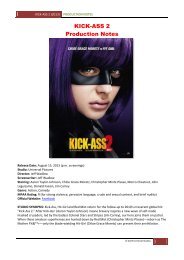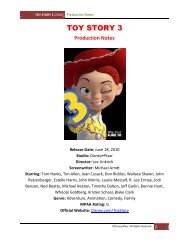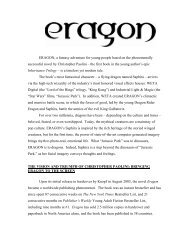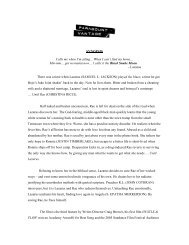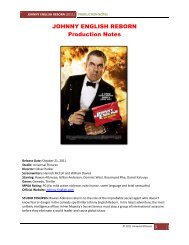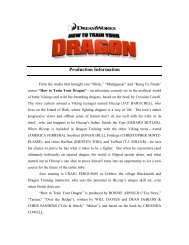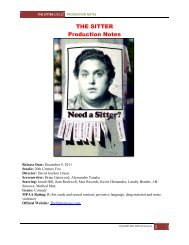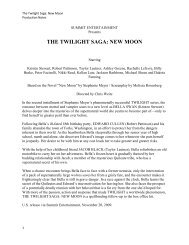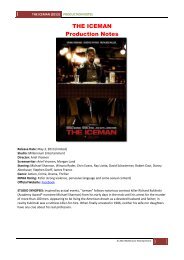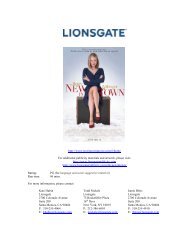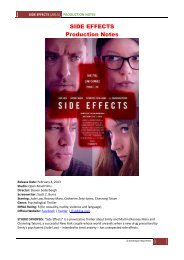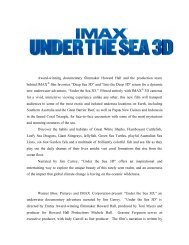FOX SEARCHLIGHT PICTURES PRESENTS An ... - Thecia
FOX SEARCHLIGHT PICTURES PRESENTS An ... - Thecia
FOX SEARCHLIGHT PICTURES PRESENTS An ... - Thecia
Create successful ePaper yourself
Turn your PDF publications into a flip-book with our unique Google optimized e-Paper software.
the movie,” Fanning explains, “because it was looked down upon for a young white girl to be<br />
living with African-American people. This is something my character can’t understand.”<br />
Hudson says her character and Fanning’s were bound together by shared needs. “They<br />
both have a struggle: Rosaleen wants to be acknowledged as a human being while Lily is looking<br />
for a mother. So where one is weak, the other is strong.”<br />
Given that neither actress could reference the 1960’s from personal knowledge, Prince-<br />
Bythewood tried to create an environment steeped in the period. “Only 60’s music was allowed<br />
on the set — a lot of Motown,” says Prince-Bythewood, who would not even allow modern music<br />
in her own car on the way to work. The director also created an elaborate improv to help them<br />
get into character. Before filming began, while on location in downtown Burgaw, a little town in<br />
North Carolina, the director had Fanning and Hudson meet at a drugstore where they were told to<br />
purchase 10 items and eat a meal. Extras in the drugstore had been instructed by the director to<br />
interact respectfully with Fanning, but to ignore Hudson. “I couldn’t hear what that guy at the<br />
counter said to Jennifer, but I know what I told him to say,” Prince-Bythewood recalls. “When I<br />
saw her head whip around so fast, I was thinking ‘Oh my God, is she going to hit him?’ ”<br />
Acknowledging the impact of those exercises - and the historical research she did - on her<br />
performance, Hudson says she developed an overwhelming sense of gratitude at being young<br />
today. “I was sitting watching a little white girl and a little black boy reading a book together<br />
recently and I thought ‘Wow that would have been illegal 50 years ago.’” She adds, “You have to<br />
know where you’ve come from to know where you’re going and you need to know what mistakes<br />
you made, so you don’t make them again. This was a part of our history.”<br />
For Hudson, the closeness she experienced with her fellow actors on the set mirrored her<br />
feelings about the film itself. “It’s about togetherness,” she says. “If we stick together, there’s so<br />
much we can accomplish, because no matter what the struggle, as long as you’ve got somebody,<br />
you can make it.”<br />
Ironically, however, Prince-Bythewood says that one of the most memorable scenes for<br />
her involved the opposite emotion, when Lily tells August Boatwright (Queen Latifah) she is<br />
unlovable. “It just kills me,” Prince-Bythewood says, noting that the sheer vulnerability exuded<br />
by Fanning, coupled with the tenderness Latifah summons to heal her, in many ways is at the core<br />
of the film’s concerns. “This film is about love and finding the mother within yourself,” she says.<br />
To handle a scene like that required a multifaceted actress who could portray August<br />
Boatwright as a loving matriarch who nurtures both her younger sisters and the two lost souls<br />
who come to her house in need of love. “Queen Latifah just embodies August’s character,” says<br />
6




